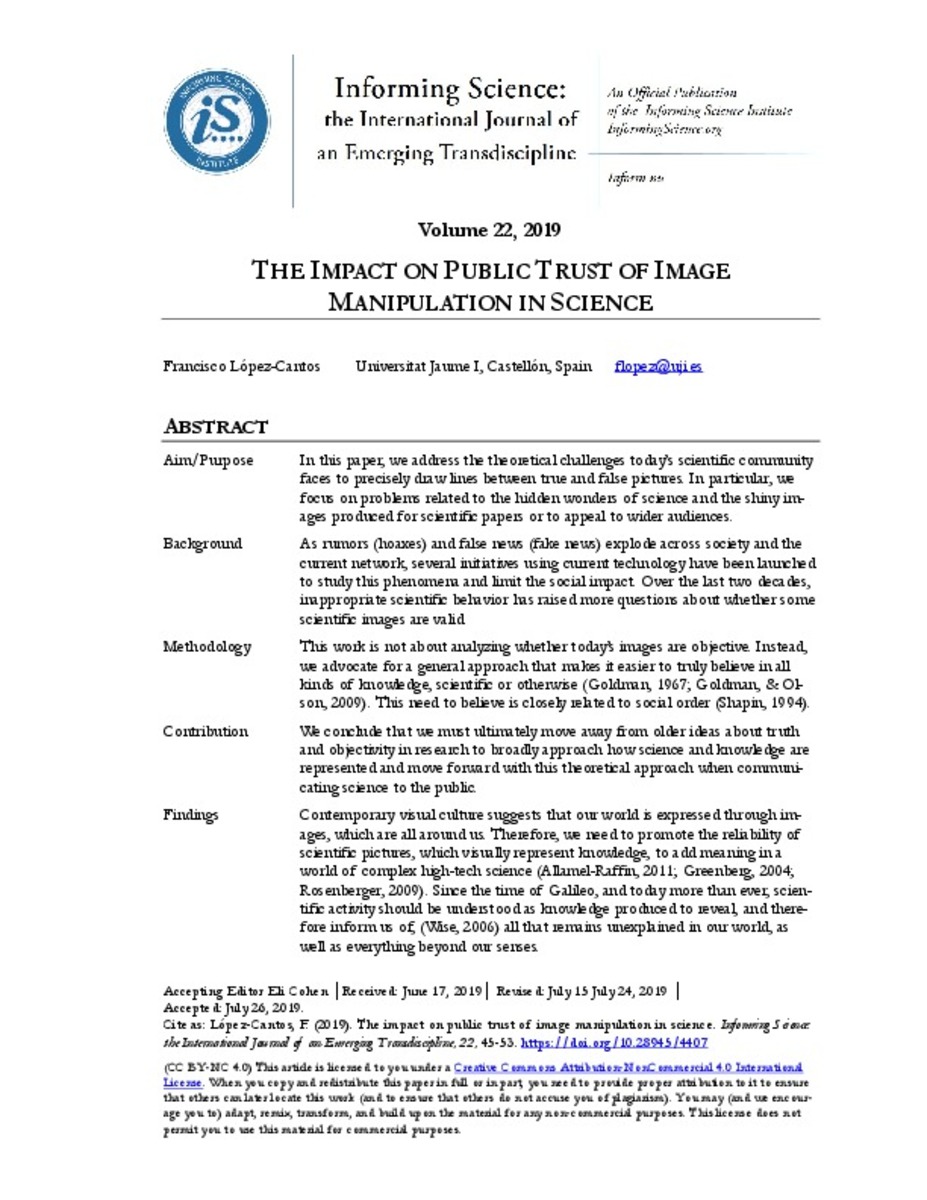Mostra el registre parcial de l'element
The Impact on Public Trust of Image Manipulation in Science
| dc.contributor.author | López-Cantos, Francisco | |
| dc.date.accessioned | 2019-10-03T11:16:29Z | |
| dc.date.available | 2019-10-03T11:16:29Z | |
| dc.date.issued | 2019-07 | |
| dc.identifier.citation | López-Cantos, F. (2019). The impact on public trust of image manipulation in science. Informing Science: the International Journal of an Emerging Transdiscipline, 22, 45-53. https://doi.org/10.28945/4407 | ca_CA |
| dc.identifier.uri | http://hdl.handle.net/10234/184044 | |
| dc.description.abstract | Aim/PurposeIn this paper, we address the theoretical challenges today’s scientific community faces to precisely draw linesbetween true and false pictures. In particular, we focus onproblems related to the hiddenwonders ofscience and the shiny im-ages produced for scientific papers or to appeal towider audiences. BackgroundAs rumors (hoaxes) and false news (fake news)explode acrosssociety and the current network, severalinitiatives using current technologyhave been launched to study this phenomena and limit the social impact. Over the last two decades, inappropriate scientific behavior has raisedmore questions about whether some scientific images are valid.MethodologyThis work is not about analyzing whethertoday’s imagesare objective.Instead,weadvocate for a general approach thatmakes it easier to truly believe in all kinds of knowledge, scientific or otherwise (Goldman, 1967; Goldman, & Ol-son, 2009). This need to believe is closely related to social order (Shapin, 1994). ContributionWe conclude that we must ultimately move away from older ideas about truth and objectivity in research to broadly approach howscience and knowledge are represented and move forward with this theoretical approach when communi-catingscience tothe public.FindingsContemporary visual culture suggests that our world is expressed through im-ages, which areall around us. Therefore,we need to promote thereliability of scientific pictures, which visually represent knowledge, to add meaning in a world of complex high-tech science (Allamel-Raffin, 2011; Greenberg, 2004; Rosenberger, 2009). Since the time of Galileo, and today more than ever, scien-tific activity should be understood as knowledgeproduced toreveal, and there-fore inform us of, (Wise, 2006) all that remains unexplained in our world , as well as everything beyond our senses. | ca_CA |
| dc.format.extent | 9 p. | ca_CA |
| dc.format.mimetype | application/pdf | ca_CA |
| dc.language.iso | eng | ca_CA |
| dc.publisher | Informing Science Institute | ca_CA |
| dc.rights | Atribución-NoComercial 4.0 Internacional | * |
| dc.rights.uri | http://creativecommons.org/licenses/by-nc/4.0/ | * |
| dc.subject | fake pictures | ca_CA |
| dc.subject | scientific fraud | ca_CA |
| dc.subject | scientific pictures | ca_CA |
| dc.subject | public understanding of science | ca_CA |
| dc.subject | science communication | ca_CA |
| dc.subject | science journalism | ca_CA |
| dc.title | The Impact on Public Trust of Image Manipulation in Science | ca_CA |
| dc.type | info:eu-repo/semantics/article | ca_CA |
| dc.identifier.doi | https://doi.org/10.28945/4407 | |
| dc.rights.accessRights | info:eu-repo/semantics/openAccess | ca_CA |
| dc.relation.publisherVersion | http://www.inform.nu/Articles/Vol22/ISJv22p045-053Lopez5712.pdf | ca_CA |
| dc.type.version | info:eu-repo/semantics/publishedVersion | ca_CA |
Fitxers en aquest element
Aquest element apareix en la col·lecció o col·leccions següent(s)
-
COM_Articles [810]








